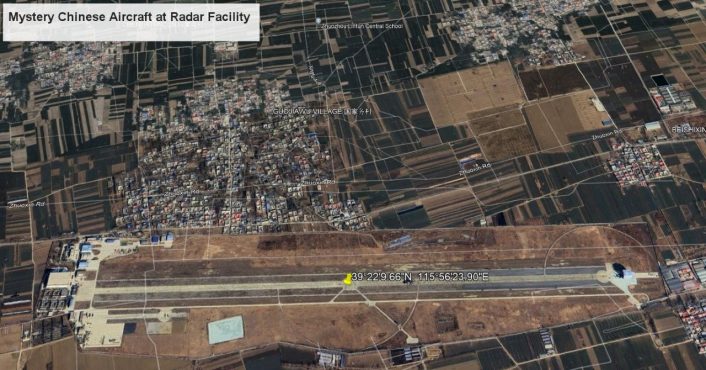The Chinese mystery aircraft might not be an actual flying asset but rather a model used to test the design’s radar characteristics.
A mysterious flying-wing aircraft appeared in satellite images of a known Chinese RCS (Radar Cross Section) test site at Baoding, in eastern China’s Hebei province, earlier this year. The aircraft, possibly a model of an under-development UCAV (Unmanned Combat Aerial Vehicle), is similar in appearance to Northrop Grumman’s X-47B UCAV, with its cranked-kite configuration.
The same facility was also used to test the stealth characteristics of the Hongdu GJ-11 Sharp Sword. Observers believe the GJ-11 might eventually fly from Chinese aircraft carriers given how its mock-ups have been seen on full-sized carrier test facilities in unofficial photographs.
The latest pictures of the unknown aircraft, whose existence was first reported by Aviation Week, were taken by Airbus’s satellites, viewable on Google Earth, on Feb. 12, 2024. The area shown is the Hebei facility for testing stealth aircraft, whose satellite pictures were comprehensively analyzed by Covert Shores in Sep. 2021.
Mystery Aircraft
The aircraft is located at the eastern end of the runway behind a hangar. Using photo analysis tools, the aircraft’s overall wingspan comes roughly at 55.64 feet. It doesn’t seem to have a cockpit for manned flight, which suggests it could be a drone or a UCAV (Unmanned Combat Aerial Vehicle).
So far, however, the aircraft appears to be just a model for testing purposes. If that model pertains to a planned drone or a full-sized aircraft is not yet known. The aircraft is also not covered from overhead satellites by placing it under the rail-mounted hangar. This structure can be rolled back and forth to protect classified test objects from prying overhead reconnaissance.
The object’s design is somewhat similar to the Northrop Grumman’s X-47B, sharing the blended-wing-body airframe and the cranked-kite wing configuration. While the X-47B is tailless, the unidentified Chinese aircraft seems to sport two small canted vertical stabilizers towards the trailing edge.

Air inlets for the engines, if any, are not visible, possibly because they could have been omitted on the test model. Perhaps, they might be built into the ventral side, or simply not visible in the photograph.
Speaking to The Aviationist, leading Chinese military aviation analyst Andreas Rupprecht said the “shape” is “real” since it was “spotted at the PLA Air Force RCS test facility.” This means the image is not fake or doctored.
However, he believes it might not be an actual flying model and “just a shape tested there similar to many others and sometimes even stranger ones.” Its actual status in PLA weapons development plans is not known.
When you think of a Pure Flying Wing, the N-9M comes to mind but #DYK about the autonomous tailless Kite Wing variations, the Cranked-Kite Wing X-47B and Kite Wing X-47A? #NorthropGrumman #FlyingWingFriday #avgeek pic.twitter.com/tQ3utw0TC1
— Northrop Grumman (@northropgrumman) February 8, 2019
The Test Facility
At the apron on the runway’s eastern end, a pedestal can be spotted, where test models are usually installed for various experiments. Just beside the apron (towards the east) there is the movable hangar, beside which the mystery aircraft is located, amid other unidentified clutter. This is consistent with the site being an RCS (Radar Cross Section) testing facility, as was reported by Covert Shores.
Towards the west, there are two more pedestals – one almost in the middle and another further away. “Since 2013 the site has been successively improved. The apron at the western end has been enlarged and a large hangar was built in 2016. There appear to have been spikes in activity in 2016-17 and again in 2020-21,” Covert Shores said.
Generally, at such facilities, engineers would install the articles and have radar/s placed around it to analyze its return. This is to validate both the supposed LO (Low Visibility) and radar absorbing materials on the aircraft and its vulnerability to electromagnetic emission from front, side and rear aspects.
Similarly, such a facility also serves to test the performance of the radars itself, particularly stealth-beating ones. China claims its YLC-series of radars have this capability.
Lockheed Martin Skunk Works’ Have Blue, that directly led to the development of the F-117A Nighthawk, was captured in a famous photograph, mounted on a pedestal during tests. The Have Blue had inward-facing canted tails and an aerodynamically unstable design, which was maintained by a powerful FCS (Flight Control System).

China’s GJ-11 UCAV
The GJ-11 Sharp Sword, developed by the AVIC (Aviation Industry Corporation of China), meanwhile, is believed to be eventually slated for induction. The drone is also considered a sign that the PLA Navy is aggressively pushing towards acquiring a carrier-capable UCAV capability.
The GJ-11 was first officially revealed in an October 2019 military parade marking the 70th anniversary of the PRC (People’s Republic of China). It was also seen in unofficial photographs of a mock-up of the drone on a full-sized carrier test facility in late December last year.
Via ACuriousPLAFan/SDF: 😮
Supposedly not a recent image, but still the carrier mock-up and test facility at Wuhan has gained some new aircraft: Visible now are clearly mock-ups of J-15, J-35, KJ-600 and a GJ-11H on the flight deck.
(Image via @伏尔戈星图 from Weibo) pic.twitter.com/UL6uk81zh4
— @Rupprecht_A (@RupprechtDeino) December 19, 2023
That facility, located in Wuhan, had dummies of the J-15, J-35/J-31/FC-31 Gyrfalcon and a KJ-600 on the flight deck. Another PLA expert, Rick Joe, called this a “near confirmation” that a “flying wing UAV/UCAV is intended for carrier aviation,” adding that the GJ-11 is “likely already being tested.” Subsequently in Feb. 2024, a scale model was displayed at the Singapore Air Show.
GJ-11 on display with a scale model at the Singapore Air Show 2024.#SingaporeAirShow2024 https://t.co/AD6oYxfjy8 pic.twitter.com/8BAnXGGU1G
— International Defence Analysis (@Defence_IDA) February 19, 2024

